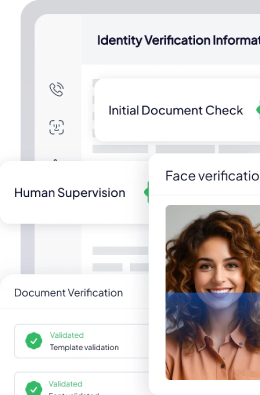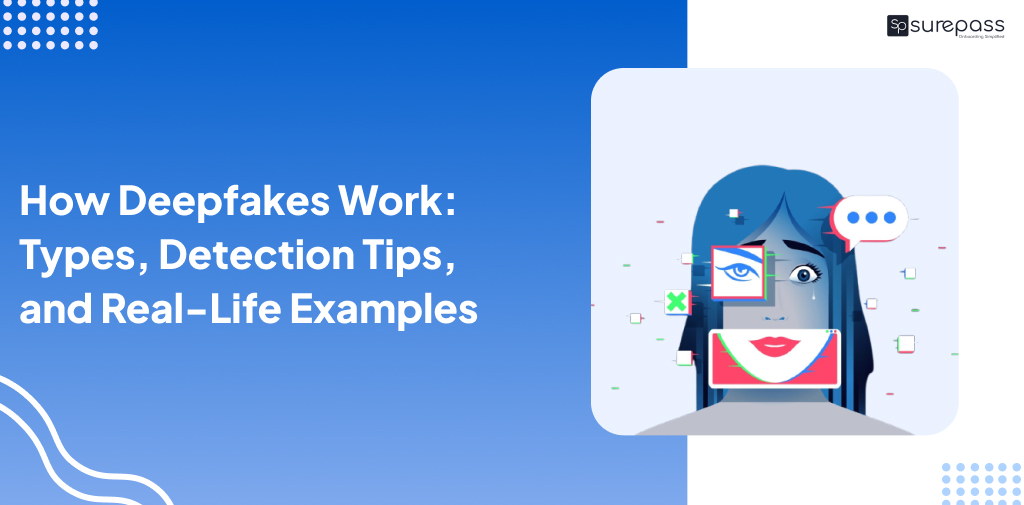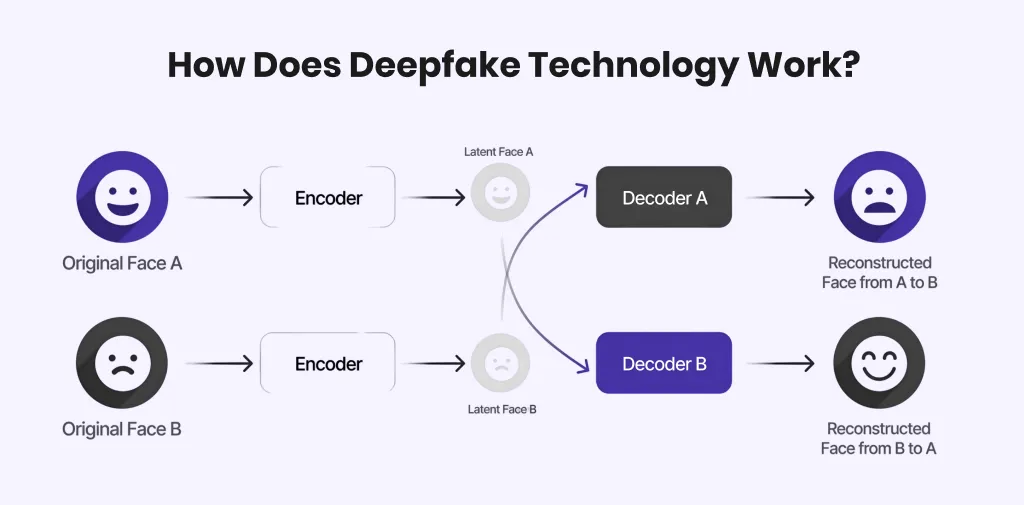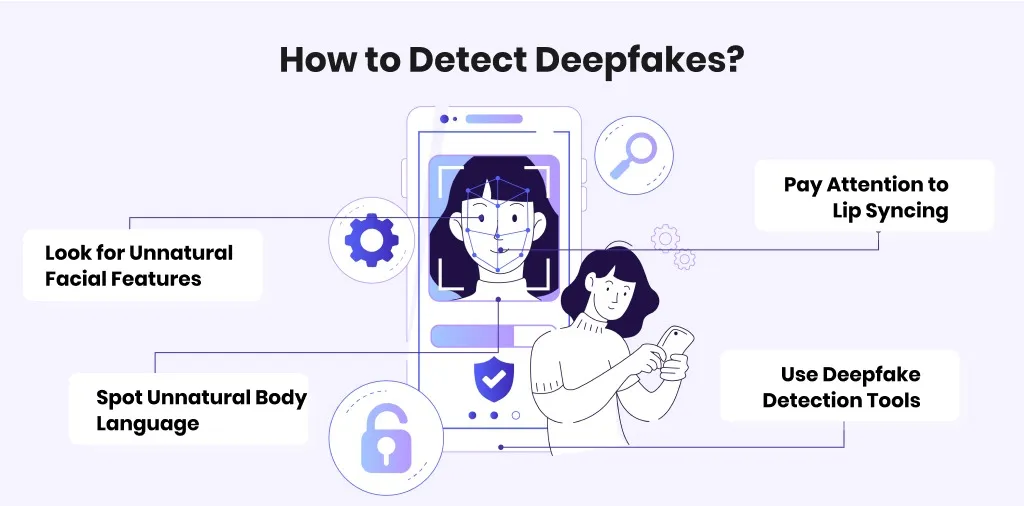You must have seen various realistic videos and images over social media of celebrities who are not real. Do you know they are created with the help of Deepfake technology? These videos and images look exactly similar to the real one. This technology is revolutionary and is used in various fun projects. However, it has been reported to be used in many fraud cases, where it has passed various biometric and verification checks like liveness detection. Here, in this guide, you will learn about Deepfake in detail.
What is Deepfake?
Deepfake refers to a photo, video, or audio that is fake but appears to be real. On splitting the word Deepfake, “deep” refers to deep learning (a part of AI), and “fake” means not real. With the technology, people can generate faces, voices, or expressions highly accurate or similar to real ones.
What is Deepfake AI?
Deepfake AI is a type of Artificial intelligence (AI). It generates realistic fake photos, videos, or audio by copying the appearance, voice, or expressions of real people. It uses deep learning algorithms to deeply learn real human faces, voices, and movements. After learning the real faces, Deepfake AI generates fake media that looks real.
Example:
- An AI can create a video of a person doing or saying something that the person has never done in reality.
- It is able to clone voices to make fake phone calls sound like a real person.
How Does Deepfake Technology Work?
Here is how Deepfake Works:
Data Collection
It requires a large collection of real images, videos, and audio recordings. This data helps create a highly accurate Deepfake. The AI learns how the person looks, speaks, and moves from different angles and under different lighting.
AI Model Training
After the collection of data, the AI is trained through a deep learning model called a GAN (Generative Adversarial Network). GAN has two parts:
Generator: It creates fake images or videos.
Discriminator: The discriminator checks whether the generator media looks real or not. It forces the generator to keep monitoring until the fake content looks similar to real footage.
Face Mapping and Replacement
After training, the AI learns to map key facial features like:
- Eye Position
- Nose Shape
- Mouth Movement
- Head Angles
After learning all these AI uses, this knowledge to swap the target person’s face with another video. It matches expressions, head movements, and lightning. It makes it hard to spot the difference.
Audio Synchronisation (If Required)
If you want a speech in the video. The technology also uses voice cloning AI to mimic a person’s voice. It syncs the fake voice with the lip movements and makes the video realistic.
Final Rendering
Once the Deepfake is generated, the AI processes the final video or image. The output result looks so real that you can’t differentiate it with human eyes.
Automate your KYC Process & reduce Fraud!
We have helped 200+ companies in reducing Fraud by 95%
Types of Deepfakes
Here are the main types of Deepfakes:
- Videos
In this kind of Deepfake, AI swaps a person’s face with another in a video. It creates a realistic video that does not exist.
- Audio
In Audio Deepfake, AI copies the voice of a given person and generates speech that sounds real. It can be used for fake phone calls, voice notes, or audio clips.
- Images
Here, AI generates new photos of people who don’t even exist or modifies real photos. It swaps faces and changes expressions without losing originality.
- Text
Modern AI models can copy a person’s writing style to produce fake emails, chats, and other documents. If you see them with the human eye, you can’t detect the document forgery and other manipulations as they look authentic.
- Puppetry
AI maps can swap face and full-body movements. It gives access to control other actions digitally.
How to Detect Deepfakes?
Even though the Deepfake AI generates realistic images and videos, it still has some issues:
- Look for Unnatural Facial Features
The most common sign of a Deepfake is the presence of unnatural facial features. The clear hints of Deepfakes are unnatural eye blinking patterns, blurry edges around the face, etc.
- Pay Attention to Lip Syncing
The fake videos sometimes fail to perfectly align spoken words with mouth movements. If the lip movement is seen as unnatural in comparison with the audio. It indicates the video is fake.
- Spot Unnatural Body Language
Carefully check the body language, notice whether the body is looking stiff, robotic, or exhibiting awkward movements. If the movement does not match the natural or original body movement, the body is likely a Deepfake.
- Use Deepfake Detection Tools
Deepfake detection tools help in the identification of AI-generated fake images, videos, and audio by analysing visual and audio inconsistencies. They are useful to prevent fraud, misinformation, and identity theft. They use face recognition technology that detects false faces with advanced data mapping.
Negative Use of Deepfake with real examples
- Deepfake of Ukrainian President Zelensky
During the Russian and Ukrainian war, a Deepfake video of President Zelensky was released in which he was ordering soldiers to surrender.
- Financial Fraud
A fraudster used AI-generated audio to mimic a CEO’s voice. In which the CEO is instructing an employee to transfer $2,43,000 to a fraudulent account.
- Romance Scams
A 77-year-old former lecturer lost a huge sum of money to an online romance scammer. They used Deepfake videos to pose as a potential partner. The victim was convinced by the realistic videos and ended up transferring large sums of money.
Conclusion
Deepfake technology is an advanced innovation that shows the capabilities of artificial intelligence. It helps in creating realistic videos and images. However, it is being misused for identity theft, misinformation, and financial fraud. Everyone needs to be informed about this technology, its misuse, and detection to protect themselves from fraud. Deepfake knowledge can help you in creating fun projects and a realistic experience. But its unethical use is illegal and a punishable offence.
FAQs
What is a sign that an Audio or clip was created using Deepfake technology?
Unnatural facial movements and inconsistencies are sign that the Audio or clip was created using Deepfake technology.
What is a Deepfake in cybersecurity?
Deepfake in cybersecurity refers to the AI-generated fake audio, video, and images to commit fraud and illegal activities.
What is an example of a Deepfake?
The shocking example of Deepfake is of Ukrainian President Zelensky, where he was convincing soldiers to surrender.
Is Deepfake Legal in India?
It is legal in India. However, its misuse is an illegal and punishable act.







